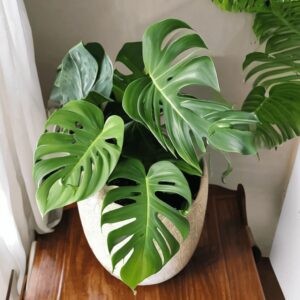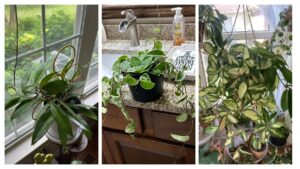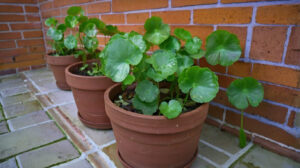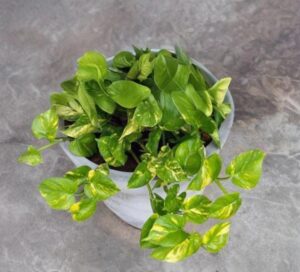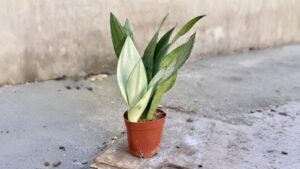
Proper drainage is essential for the health of your indoor herbs. In this article, we will discuss why drainage is important, how to add drainage holes to your pots, and other tips for growing herbs indoors.
In this article
- 0.1 Why is Drainage Important?
- 0.2 Adding Holes to the Pot
- 0.3 Growing Herbs in Pots Without Drainage Holes
- 0.4 Watering Indoor Herbs—But Not Too Much
- 0.5 Signs of Trouble: Symptoms to Watch Out for in Pots Without Drainage Holes
- 0.6 Using a Cache Pot for Indoor Herb Gardening
- 1 What Soil is Best for Indoor Herbs?
- 1.1 Recommended Soil Types
- 1.2 How much soil do you need?
- 1.3 Considerations for Herb Types
- 1.4 Additional Tips
- 1.5 Double Potting
- 1.6 Self-Watering Pots
- 1.7 Use Pebbles
- 1.8 Allowing Roots to Breathe Freely
- 1.9 Avoiding Bacterial and Fungal Diseases
- 1.10 Flushing Salts from the Soil
- 1.11 Fertilizing Your Plants
- 1.12 Choose the Sunniest Spot
- 1.13 The Right Temperature for Growing Herbs Indoors
- 1.14 Humidity for Indoor Herbs
- 1.15 Harvest a Little at a Time
- 1.16 Transplant When Ready
- 1.17 Tips for a Successful Indoor Herb Garden
Why is Drainage Important?
Herbs do not like to be kept in standing water, so there needs to be a way for the water to drain out of the pot. Without proper drainage, the roots of your herbs can become waterlogged and begin to rot. This can lead to stunted growth, yellowing leaves, and even death of the plant.
Adding Holes to the Pot
If your pot does not have drainage holes, you can add them yourself. Here are some ways to do it:
- Use a drill to create holes in the bottom of the pot.
- Place a layer of gravel or pebbles in the bottom of the pot to create a drainage layer.
- Use a cache pot, which is a decorative outer pot that holds a smaller pot with drainage holes.
Growing Herbs in Pots Without Drainage Holes
If you have a pot without drainage holes, you can still grow herbs in it. Here are some tips:
- Water your herbs sparingly to avoid overwatering.
- Use a well-draining potting mix.
- Add a layer of gravel or pebbles to the bottom of the pot to create a drainage layer.
- Use a cache pot to hold the pot without drainage holes.
Watering Indoor Herbs—But Not Too Much
When it comes to watering your indoor herbs, less is more. Overwatering can lead to root rot and other problems. Here are some tips for watering your herbs:
- Water your herbs when the top inch of soil feels dry to the touch.
- Water your herbs thoroughly, but allow the excess water to drain out of the pot.
- Do not let your herbs sit in standing water.
Do you know your parsley from your cilantro?
Take these 6 easy questions and test your herb knowledge.
Have fun!

Question
Your answer:
Correct answer:
Your Answers
Signs of Trouble: Symptoms to Watch Out for in Pots Without Drainage Holes
If your herbs are not getting enough drainage, you may notice the following symptoms:
- Yellowing leaves
- Wilting leaves
- Stunted growth
- Root rot
Using a Cache Pot for Indoor Herb Gardening
A cache pot is a decorative outer pot that holds a smaller pot with drainage holes. It is a great option for growing herbs in pots without drainage holes. Here are some tips for using a cache pot:
- Choose a cache pot that is slightly larger than your inner pot.
- Make sure your inner pot has drainage holes.
- Water your herbs sparingly to avoid overwatering.
What Soil is Best for Indoor Herbs?
To successfully grow indoor herbs, selecting the right soil is crucial. Here are the best options and considerations for soil types suitable for indoor herb gardening:
Recommended Soil Types
1. Indoor Potting Mix
- The most commonly recommended soil for indoor herbs is a high-quality indoor potting mix. This mix is designed to be lightweight and well-draining, preventing compaction and ensuring that roots can breathe effectively.
- It retains moisture while allowing excess water to drain away, which is essential for preventing root rot.
2. Perlite Addition
- Adding perlite to your potting mix can enhance drainage and aeration. A typical ratio is about 2 parts potting mix to 1 part perlite.
- This combination helps create air pockets in the soil, promoting healthier root growth and reducing the risk of overwatering.
3. Coconut Coir
- Coconut coir is another excellent alternative that resists compaction and retains moisture without becoming soggy. It has a neutral pH and supports beneficial microbial activity in the soil.
- It can be mixed with potting soil to improve moisture retention, making it suitable for herbs that prefer a bit more water, like cilantro or chives.
4. Peat Moss
- Peat moss is often used in potting mixes due to its ability to retain moisture while providing good drainage. It is particularly beneficial for acid-loving herbs like parsley.
- Its sterile nature makes it an excellent choice for starting seeds or growing microgreens indoors.
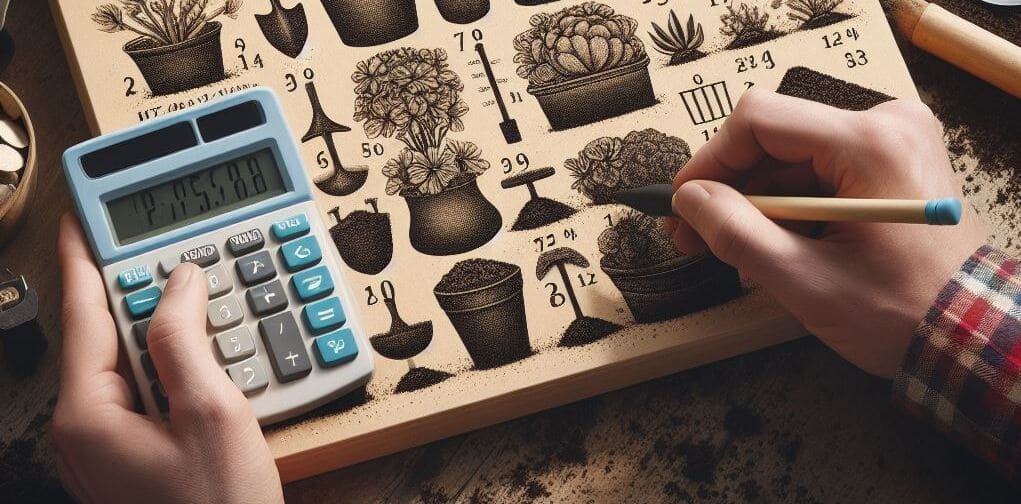
How much soil do you need?
Calculate the amount of soil needed for your raised garden bed, potting container, or garden container with this handy soil calculator.
Considerations for Herb Types
Different herbs have varying needs when it comes to soil:
- Drought-Tolerant Herbs (e.g., Oregano, Rosemary): These herbs thrive in well-draining soils that may contain sand or additional inert materials like vermiculite.
- Moisture-Loving Herbs (e.g., Basil, Cilantro): They benefit from potting soils with higher moisture retention capabilities, such as those containing coconut coir or peat moss.
Additional Tips
Fertilization: Use an organic fertilizer high in nitrogen to support leaf growth, especially during the growing season
Avoid Outdoor Gardening Soil: Outdoor soil tends to be too compacted and can harbor pests, making it unsuitable for indoor herb gardening.
Double Potting
Double potting is a technique that involves placing a smaller pot with drainage holes inside a larger pot without drainage holes. This creates a drainage layer between the two pots. Here are some tips for double potting:
- Choose a smaller pot with drainage holes.
- Place the smaller pot inside a larger pot without drainage holes.
- Add a layer of gravel or pebbles to the bottom of the larger pot to create a drainage layer.
Self-Watering Pots
Self-watering pots are a great option for busy gardeners. These pots have a reservoir that holds water, which is slowly released to the plant as needed. Here are some tips for using self-watering pots:
- Choose a pot that is the right size for your plant.
- Fill the reservoir with water as needed.
- Check the soil moisture regularly to make sure your plant is not getting too much or too little water.
Use Pebbles
Adding a layer of pebbles to the bottom of your pot can help improve drainage. Here are some tips for using pebbles:
- Choose pebbles that are small enough to fit through the drainage holes.
- Add a layer of pebbles to the bottom of your pot before adding soil.
- Make sure the pebbles do not cover the drainage holes.
Allowing Roots to Breathe Freely
Roots need oxygen to grow and thrive. If your soil is too compacted, your herbs may not be getting enough oxygen. Here are some tips for allowing roots to breathe freely:
- Use a well-draining potting mix.
- Add perlite or vermiculite to your potting mix to improve drainage.
- Avoid compacting the soil when planting your herbs.
Avoiding Bacterial and Fungal Diseases
Bacterial and fungal diseases can be a problem for indoor herbs. Here are some tips for avoiding these diseases:
- Use a well-draining potting mix.
- Water your herbs sparingly to avoid overwatering.
- Make sure your herbs are getting enough light and air circulation.
Flushing Salts from the Soil
Over time, salts can build up in the soil and cause problems for your herbs. Here are some tips for flushing salts from the soil:
- Water your herbs thoroughly until water runs out of the drainage holes.
- Repeat this process every few months to flush out excess salts.
Fertilizing Your Plants
Fertilizing your herbs can help them grow strong and healthy. Here are some tips for fertilizing your plants:
- Use a balanced fertilizer that is specifically designed for herbs.
- Follow the instructions on the fertilizer package.
- Do not over-fertilize your herbs.
Choose the Sunniest Spot
Most herbs need at least six hours of sunlight per day. Choose a sunny spot for your indoor herb garden. Here are some tips for choosing the right spot:
- Choose a spot that gets at least six hours of sunlight per day.
- If you do not have a sunny spot, consider using grow lights.
The Right Temperature for Growing Herbs Indoors
Most herbs prefer temperatures between 60 and 70 degrees Fahrenheit. Here are some tips for maintaining the right temperature:
- Keep your herbs away from cold drafts and hot radiators.
- Use a thermometer to monitor the temperature in your indoor herb garden.
Humidity for Indoor Herbs
Most herbs prefer moderate humidity levels. Here are some tips for maintaining the right humidity:
- Mist your herbs regularly with a spray bottle.
- Place a tray of water near your herbs to increase humidity.
Harvest a Little at a Time
Harvesting your herbs regularly can help them grow stronger and healthier. Here are some tips for harvesting your herbs:
- Harvest your herbs regularly to encourage new growth.
- Do not harvest more than one-third of the plant at a time.
Transplant When Ready
When your herbs outgrow their pots, it is time to transplant them. Here are some tips for transplanting your herbs:
- Choose a pot that is slightly larger than your current pot.
- Use a well-draining potting mix.
- Water your herbs thoroughly after transplanting.
Tips for a Successful Indoor Herb Garden
Here are some additional tips for growing a successful indoor herb garden:
- Choose the right herbs for your space and needs.
- Use a well-draining potting mix
In conclusion, proper drainage is essential for the health of your indoor herb garden. Without it, your herbs can become waterlogged and begin to rot. Adding drainage holes to your pot, using a cache pot, and choosing the right soil are just a few ways to ensure your herbs thrive.
It may take time to setup at first, but the results will be worth it.
Do you REALLY know your gardening?
Take this quiz to see if you are a gardening expert.
These 6 questions are really tough!! Good luck!

Question
Your answer:
Correct answer:
Your Answers
Happy gardening!

